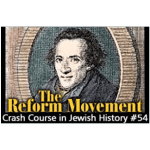History Crash Course #48: The Spanish Inquisition
In Part 45, when we discussed the Crusades, we covered the war of the Church against the Muslims in the Middle East. Now we turn to the war of the Church against Muslims in Europe. This war went on for quite some time in fits and starts ? from the time the Muslim Moors arrived in Spain in 711. It took a long time for the Christians to vanquish them. The first Muslim stronghold to fall was Toledo in 1085; the last was Granada in 1492.
As the Christian re-conquest gained momentum, Jews in these newly re-conquered Christians territories began to suffer from increasingly harsher persecutions.
In their blood-thirsty vengeance against the Muslims, the Spanish Christians included the Jews, whom they put in the category of infidels.
In 14th century Barcelona, for example, the whole Jewish community was murdered by a rioting mob. First given shelter by some Christians, these Jews were pressured to convert. Those who did not were refused protection.
Writes Professor B. Netanyahu in his 1,400-page work, The Origins of the Inquisition, quoting an eyewitness account of the time:
“Those of them who refused to accept baptism were immediately slain, and their corpses, stretched in the streets and the squares, offered a horrendous spectacle.” (p. 159)
Just how many Jews converted in these forced mass conversions that accompanied the Christian conquest of Spain? Estimates rage between tens of thousands to as many as 600,000. (See The Origins of the Inquisition, p. 1095.)
Many of those who converted did so only outwardly, continuing to practice Judaism in secret. In due time, the Christians caught on to these phony conversions and decided to root out the heretics.
The Spanish Inquisition
The Inquisition we are going to cover now is the Spanish Inquisition, which began officially by papal bull issued by Pope Sixtus IV on November 1, 1478.
(We should note, however, that the very first Inquisition actually took place in 1233 under orders from Pope Gregory IX to combat a group of French-Christian heretics called “Albigenses.” This first Inquisition was relatively mild and did not as a rule sentence people to death. Not so the Spanish Inquisition which was directed against Jewish “heretics”.)
Unlike its earlier version, the Spanish Inquisition sought to punish Jews who had converted to Christianity but were not really “sincere” in their conversions.
There is a great deal of irony in this. First you tell people they have to convert or die, then, when they do convert, you decide to kill them anyway because their conversions are not “sincere.”
There was another reason for the Inquisition, which had little to do with the sincerity of conversions. Once Jews converted to Christianity they had an open access to the playing field, economically and politically. And, of course, they prospered mightily. That engendered a lot of hostility from the Christians ? a pattern we have seen in Jewish history ever since the enslavement of the Israelites by the Egyptians.
The Christians began to call converted Jews “New Christians” to distinguish them from the “Old Christians” i.e. themselves. Derogatorily, Jewish converts to Christianity were called conversesmeaning “converts,” or worse yet marranos, meaning “pigs.”
The basic accusation was that these Jews were not real converts to Christianity ? they were secretly practicing Judaism. That was certainly often the case. There were large numbers of Jews who would be outwardly Christian but who would continue to practice Judaism secretly.
Until this day, there exist Christian communities with clear Jewish roots dating back to this time. There are people in the United States (in New Mexico and Arizona) as well as in South and Central America, who are descended from Spanish or Portuguese settlers, and who have strange customs they cannot explain. For example, even though they are Catholics, on Friday night they go down to the cellar to light candles. They don’t know the origins of the custom, but they do it. These people are clearly descended from Jews who pretended to be Christians and yet were practicing Jewish rituals in secret.
The job of the Inquisition was to find such people, torture them until they admitted their “crime,” and then kill them.
Ferdinand and Isabella
Every American child knows about King Ferdinand and Queen Isabella ? they are the monarchs who backed Christopher Columbus in his discovery of America. However, here are a few things that most people don’t know about them.
The marriage of Ferdinand V, and Isabella I, in 1469 unified Spain, in some measure making the final victory over the Muslims possible. Prior to their reign, Spain was a collection of provinces ? the two primary being Aragon and Castile. When Ferdinand of Aragon married Isabella of Castile, these two provinces were united by marriage into a mighty kingdom.
Isabella was a “fervent” Christian and, in 1478, she asked the Pope for permission to set up an Inquisition to weed out heresy in the Christian world. The Pope obliged, issuing on November 1, 1478, a papal bull called Exigit Sincere Devotionis. Ferdinand and Isabella followed that up with a royal decree on September 27, 1480.
One might think that ridding Christianity of heretics should involve targeting other groups, not just false Jewish converts. However, the royal decree mentioned no one else. Writes Professor B. Netanyahu (p.3):
The royal decree explicitly stated that the Inquisition was instituted to search out and punish converts from Judaism who transgressed against Christianity by secretly adhering to Jewish beliefs and performing rites and ceremonies of the Jews. No other group was mentioned, no other purpose indicated ? a fact that in itself suggest a close relationship between the creation of the Inquisition and Jewish life in Spain. Other facts, too, attest to that relationship.
Although the first inquisitors got to work a few months after the decree, it was not until 1483 ? when Tomas de Torquemada, a Spanish Dominican monk, was appointed Grand Inquisitor ? that the Inquisition got its bloody reputation. Torquemada ? who was descended from Jewish converts to Christianity some time back ? outdid the worst anti-Semites with his brutality.
(One of the most fascinating and depressing sub-plots of this drama is how many of the major Christian personalities in this story had either Jewish ancestry or were actually Jewish according to Jewish law. In addition to Torquemada, Jewish blood also flowed through the veins of:
- King Ferdinand V
- Queen Isabella I
- Diego de Raza-Grand Inquisitor after Torquemada
- Hernando de Talavera-Isabella’s personal confessor (mother was converse)
- Pedro de la Caballeria and Alanso de Cabrera ? (both converses)who helped arrange the wedding of Ferdinand and Isabella
- Gabriel Sanchez (converse) ? chief treasurer or Aragon
- Luis de Santangel (converse) ? Ferdinand’s budget Minister. (Sanchez and Santangel were responsible for financing the voyage of Christopher Columbus ? also of Jewish ancestry ? more on this later!) [1]For a more detailed description of the Jewish ancestry of these personalities see: James Reston Jr., The Dogs of God ? Columbus, the Inquisition, and the Defeat of the Moors,(Doubleday, 2005), p. 17, … Continue reading
How did the Inquisition work?
Jewish converses would be arrested and accused of not being true Christians. They wouldn’t even know who was accusing them; evidence would be presented against them in secret. Then they would be tortured until they confessed to being heretics. Then, once they confessed, they would be killed. The usual form was burning at the stake, though if they were willing to kiss the cross, they would be spared the horrible pain of burning and would be strangled instead.
The key point is that it really didn’t matter if they repented – they died either way.
What if some people refused to confess even under torture? Or worse, what if some people admitted right away to practicing Judaism secretly, but even when tortured refused to concede the truth of Christianity? If they survived the horrendous tortures, they would be burned at the stake in a ceremony called auto-da-fe meaning “act of faith.”
This went on until 1834 when the Inquisition was finally abolished, by which time every Spaniard came to fear its power. By then the Inquisition’s field of operations had spread to Christian heretics, Protestants sects, witches, and even people who read the wrong books. The Inquisition was even able to reach into territories outside of the Spanish Empire. If Jewish converses fled to other more friendly countries, the Inquisition could have followed them, even as far as Brazil, where the last person was burned at the stake in the 19th century.
Expulsion
The year 1492 marked the fall of Granada, the last Muslim stronghold on the Iberian Peninsula, bringing to an end the Muslim domination of Spain which had lasted nearly 800 years. Spain returned to being a completely Christian country.
Shortly thereafter, Ferdinand and Isabella, decided to throw all the Jews out of Spain. This time, in the expulsion edict, the monarchs were not targeting Jewish converts to Christianity, rather they were targeting Jews who had never converted. Why? The main reason stated in the Edict of Expulsion, signed on March 31st 1492, was to keep Jews from re-Judaizing the converses. Another factor that certainly played a big role (besides anti-Semitism) was that Jewish money was now needed to rebuild the kingdom after the costly war against the Muslims. Rather than slowly squeezing the money out of the Jews through taxation, it was easier to expel them all at once and confiscate the wealth and property they would leave behind.
The Edict of Expulsion declared:
Whereas, having been informed that in these kingdoms, there were some bad Christians who Judaized and apostatized from our holy Catholic faith, the chief cause of which was the communication of Jews with Christians…we ordered the said Jews in all cities, towns, and places in our kingdoms and dominions to separate into Jewries [ghettos] and place apart… hoping by their separation alone to remedy this evil… But we are informed that neither that, not the execution of some of the said Jews… has been sufficient for a complete remedy…
Therefore we… resolve to order all the said Jews and Jewesses to quit our kingdoms and never return… by the end of the month of July next, of the present year 1492… if they do not perform and execute the same, and are found to reside in out kingdoms… they incur the penalty of death… We likewise grant permission and authority to said Jews… to export their wealth and property… provided they do not take away gold, silver, money, or other articles prohibited by the laws of kingdom.
The Jews tried to get the edict reversed, of course. The key player in the drama was Don Isaac Abravanel ? who was a great Torah scholar and rabbi. He was one of the great Jewish personalities of this period of time, and had served as the treasurer of Spain, thus being the most powerful Jew in Spain. He tried very hard to rescind the expulsion order, at one point offering the monarchs 300,000 ducats for a reprieve.
He actually almost succeeded in getting the monarchs to rescind the edict, but his near-success only ignited the ire of the Grand Inquisitor Tomas de Torquemada.
According to the legend, Torquemada ? who had an enormous amount of influence over the Queen Isabella, being her confessor ? walked in while Abravanel was pleading his cause. Incensed, he threw the cross at the Queen, hitting her in the head and yelled: “Judas sold his master (Jesus) for 30 pieces of silver. Now you would sell him anew!”
And so Don Isaac Abravanel lost. But he was so important to the monarchs that they gave him a special dispensation to stay; they even agreed that another nine Jews could stay with him so he could pray with a minyan. He refused. In fact, he became the leader of the Jews of Spain as they went into exile.
The six months between the issuing of the edict and the actual expulsion were catastrophic for the Jewish community. Having lived in Spain for centuries they were now being told that they all had leave! Where would they go? To add insult to injury, they had to liquidate all their assets but could not take most of their wealth with them. They were forced to sell a massive amount of real state, personal goods and other valuables at a fraction of their actual worth. In short, most of the Jews lost virtually everything.
Now, on what day was the Jewish community sent into exile? August 2, 1492. (the original date was July 31st, but Torquemada extended it by a few days.)This day just happened to be the 9th of Av, the same date as the destruction of the first and second Temple in Jerusalem (and many other disasters as we have already seen). On that day the Jews of Spain (some 150,000 ? 200,000 people) were forced to abandon their vast possessions and leave. The remainder (around 60,000 though it’s unknown exactly how many) stayed, agreeing to convert.
Christopher Columbus
The day after the expulsion, August 3, 1492, Christopher Columbus left on his famed voyage of discovery. His diary begins:
In the same month in which their Majesties issued the edit that all Jews should be driven out of the kingdom and its territories, in the same month, they gave me the order to undertake with sufficient men my expedition of discovery of the Indies.
Many people like to speculate that Columbus was of Jewish ancestry, and there is a good case for it. (For those interested, there are a lot of fascinating tidbits about Columbus collected in a book called Christopher Columbus’s Jewish Connection by Jane Francis Amler.) [2]See also: M. Hirsh Goldberg. The Jewish Connection. (Scarborough House, 1993), pp 110-113. Here are some examples:
- Although he was born in Genoa, Italy, his first language was Castilian Spanish. Many Jews had been forced to leave Castile about hundred years before his birth and some went to Genoa. (Incidentally, 14th century Castilian Spanish is the “Yiddish” of Spanish Jewry known as “Ladino.”)
- When he wrote, Columbus made funny little marks on the page that resembled the markings that religious Jews put on top of the written page even to this day ? an abbreviation ofbesiyata d’ishmaya, which means “with God’s help” in Aramaic.
- He talked a great deal about Zion in his writings.
- In his crew, he had five known Jews, including his doctor, navigator, and translator.
- Columbus hired the translator, Louis de Torres, (who had converted to Christianity the day before he set sail) because he spoke twelve languages including Hebrew. And Columbus was sure he was not going to bump into Hebrew-speakers. He thought he was going to go to the Far East and he expected to find at least one of the ten lost tribes there and needed a Hebrew speaker.
Furthermore, there’s no question that Columbus’s voyage to America was spiritually linked to the expulsion. Just as one of the greatest Jewish communities of Medieval Europe is being destroyed, God was opening up the doors of what is going to eventually become the greatest Diaspora refuge for Jews in history ? America. This is another tremendous pattern we see in history: God making the cure before the disease.
Incidentally, Columbus’s voyage was not financed by Isabella selling her jewels as is often stated. The major financiers were two court officials ? both Jewish converses ? Louis de Santangel, chancellor of the royal household, and Gabriel Sanchez, treasurer of Aragon.
The first letter Columbus sent back from the New World was not to Ferdinand and Isabella, but to Santangel and Sanchez thanking them for their support and telling them what he found.
The voyage of Columbus is a landmark in the Age of Exploration when numerous discoverers opened up the New World. While no other is believed to be Jewish, their discoveries were, to a significant extent, made possible by Jewish inventions or Jewish improvements to existing inventions.
For example, the key tools of navigators ? the quadrant and the astral lobe used during this period- were of Jewish manufacture. In fact, the type of quadrant then in use was called “Jacob’s Staff”; it had been invented by Rabbi Levi ben Gershon also known as Gershonides.
The famous atlas that Columbus and the other explorers used was known as the Catalon Atlas. It was the creation of the Cresca Family, Jews from Majorca, Spain. Not only was the Catalon Atlas considered the greatest and most significant collection of maps at the time, it had no competition to speak of. Jews had a virtual monopoly at map making then, culling information from Jewish merchants from all over the known world.
A Blessing
While Columbus was off discovering America, what was happening to the Jews newly thrown out of Spain?
Most made their way across the border to Portugal, but their stay there was short-lived. Five years later, Portugal offered them the same choice as Spain: “convert, leave or die.” (Although rather than actually expel them – which would have caused him a massive loss of valuable Jews – the King of Portugal first abducted and forcibly baptized all Jewish children and then orchestrated a mass, forced conversion of virtually the entire Jewish population. He then forbade these “New Christians” from emigrating.)
Thousands of Jews who fled Spain went to Turkey, which historically has been very nice to the Jews. Opening his doors to them, the Sultan of the Turkish Ottoman Empire, Bayezid II, declared: “They tell me that Ferdinand of Spain is a wise man but he is a fool. For he takes his treasure and sends it all to me.”
How did the movement of the Jews affect these countries? Spain, which having discovered and colonized the new World should have been the wealthiest of countries, was bankrupt within one hundred years of the expulsion. Turkey, on the other hand, prospered. The Ottoman Empire became one of the greatest powers in the world. The next two sultans, Selim I and Suleiman I, expanded the empire as far as Vienna, Austria.
(Incidentally, it was Suleiman ? known as “Suleiman the Magnificent” – who, in 1536, re-built the walls of Jerusalem ? the same walls that stand today and define the Old City.)
If we recall the lesson of Part 4, God had given Abraham and his descendants a special blessing:
“I will bless those who bless you, and curse those who curse you, and through you, will be blessed all the families of the earth.” (Genesis 12:3)
God said to Abraham that he and his descendants ? the Jews ? would be under God’s protection. The nations and peoples who would be good to the Jews will do well. Empires and peoples that would be bad to the Jews will do poorly. To quote Thomas Newton-The Bishop of Bristol (1704-1782):
The preservation of the Jews is really one of the most signal and illustrious acts of Divine Providence… and what but a supernatural power could have preserved them in such a manner as none other nation upon earth hath been preserved. Nor is the providence of God less remarkable in the destruction of their enemies, than in their preservation… We see that the great empires, which in their turn subdued and oppressed the people of God, are all come to ruin… And if such hath been the fatal end of the enemies and oppressors of the Jews, let it serve as a warning to all those, who at any time or upon any occasion are for raising a clamor and persecution against them.
That is one of the great patterns of history that we have seen and that we will continue to see in future installments. You can literally chart the rise and fall of many of the countries and empires of the Middle East and the West by how they treated the Jews.
One such country, surprisingly, was Poland.
References
| ↑1 | For a more detailed description of the Jewish ancestry of these personalities see: James Reston Jr., The Dogs of God ? Columbus, the Inquisition, and the Defeat of the Moors,(Doubleday, 2005), p. 17, p. 30. Jane Frances Amler,Christopher Columbus’s Jewish Roots, (Aronson Inc., 1993), pp. 78-83. So many Jews lived in Spain for so long and so many were conversos that it is most probable that virtually everyone in Spain today (who can trace their ancestry back to Spain of 500 years ago or more) has some Jewish blood in their veins. |
|---|---|
| ↑2 | See also: M. Hirsh Goldberg. The Jewish Connection. (Scarborough House, 1993), pp 110-113. |










